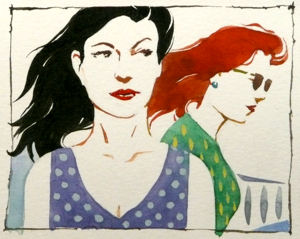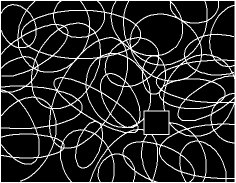|
Like a Fisherman, an Artist Casts a Hook.You want to be like a fisherman who's casting his line. But, unlike a fisherman, you are using the star of your painting or drawing as the hook to catch viewer's eyes. The star of your painting should grab the viewer's attention, draw them into the painting and give them a place to linger for a moment (or longer) before releasing them to savor the rest of your picture. And remember, the star of your painting or drawing is almost always created using one or more forms of contrast – as I've explained throughout this series of articles. In week one of this series, I showed you how to create your star using size, value or color contrast. If you missed it, click here to read it now. Last week I showed you how to create your star using shape or detail contrast. If you missed that ezine, click here to read it now. This week I'm going to show you how, like a fisherman, you can use contrast of texture, pattern and completeness to hook the viewer's eyes with your star. And, as I stated in the previous articles, values (the lightness or darkness of the colors you use) play an important part in all eight methods I'll describe in this series. PATTERN OR TEXTURE CONTRASTIn this illustration both women's dresses contain a pattern, but you see the woman on the left as the star of the picture for several reasons.  Even though the woman on the right has more intensely colored hair, the woman on the left has three strong contrasts working to draw your eye. Even though the woman on the right has more intensely colored hair, the woman on the left has three strong contrasts working to draw your eye. She is bigger (size contrast) and has much darker hair, creating stronger value contrast. She also has a stronger pattern in her dress. A different example of pattern/texture contrast is the illustration I used in last week's ezine. In that article I said the small square below stood out because its simple shape contrasted with the chaotic mixture of ellipse shapes.  I also said it stood out because it has very little detail which contrasts with the abundance of detail created by the ellipses. I also said it stood out because it has very little detail which contrasts with the abundance of detail created by the ellipses. This week I am going to suggest that we could also call this a pattern or texture contrast. I could very easily say the square has no pattern or texture, so it contrasts with the chaotic pattern or texture created by the ellipses. All of the above are true. And that is good, because, like a fisherman, it gives you many ways for your star to hook the viewer. Now you may think the above illustration is too abstract to effectively use in a painting. It isn't. To translate this into a painting, imagine having a smoothly painted object surrounded by a loose, very sketchily painted background.  My painting "Filipinas" is an example of this. My painting "Filipinas" is an example of this. Notice the sketchy, merely suggested background figures compared to the more smoothly finished foreground figures. In this painting the strokes of paint provide a rougher background texture. And as you've no doubt noticed by now, there is seldom one contrast alone that is working to define the star of your painting. COMPLETENESS CONTRASTI could just as easily argue that "Filipinas" shows completeness contrast, as well. The sketchy, suggested details in the background contrast with the more completely painted foreground figures.  But, your star doesn't have to be in the foreground for this to work. But, your star doesn't have to be in the foreground for this to work. My star in the little painting at right stands out, because of value contrast (you just can't escape it) and she is more completely finished than anything else in the painting. Notice how your eyes bounce between the man closest to you on the left and the woman in white, before venturing into the rest of the painting. But, your eyes always return to the woman in white, the star of the painting. I hope you put this and all the tips for creating your star to use. It isn't enough to read about them and think you understand them. You must consciously begin to put these principles into practice in order to improve your work. Remember, you want think like a fisherman and have the star of your painting or drawing to be strong enough to hook the viewer's eyes and draw them into your art. If you have friends you feel would enjoy this article, by all means pass it along to them. I will have one last tip for creating your star next week. Until then…… Good Fishing, Gary Gumble Without art the crudeness of reality would make the world unbearable. (George Bernhard Shaw) Go from Like a Fisherman to Part 1 Go from Like a Fisherman to Part 2 Go to Home Page |
|
|